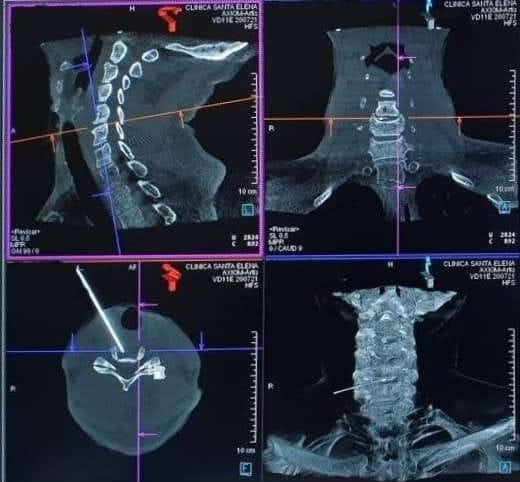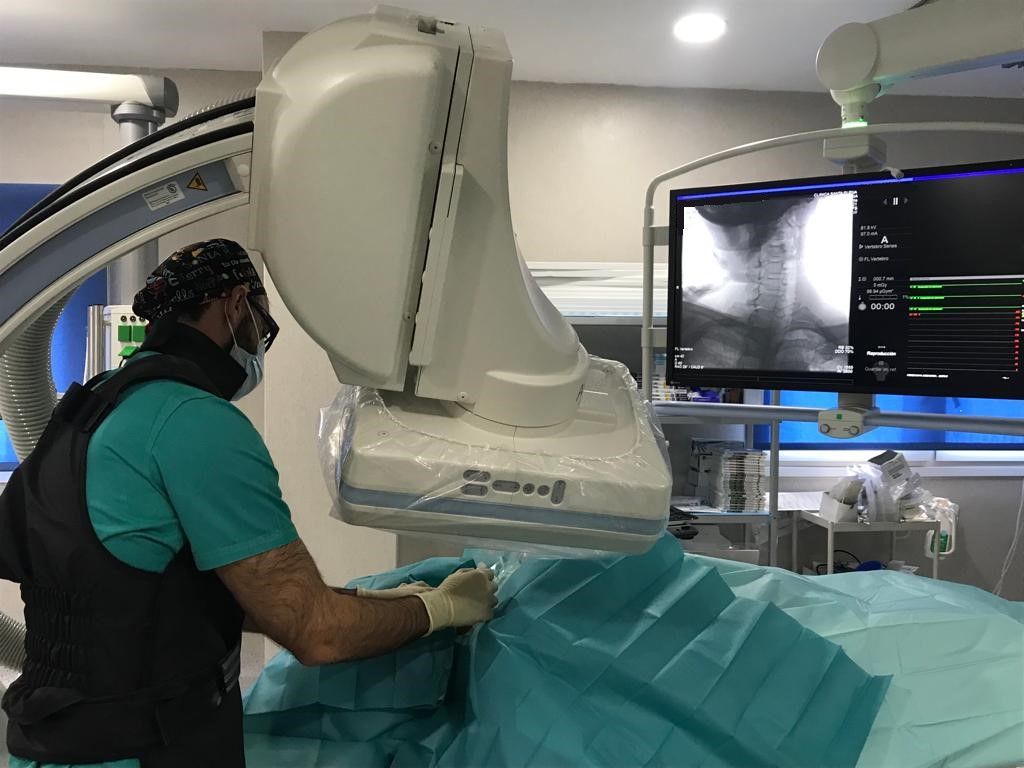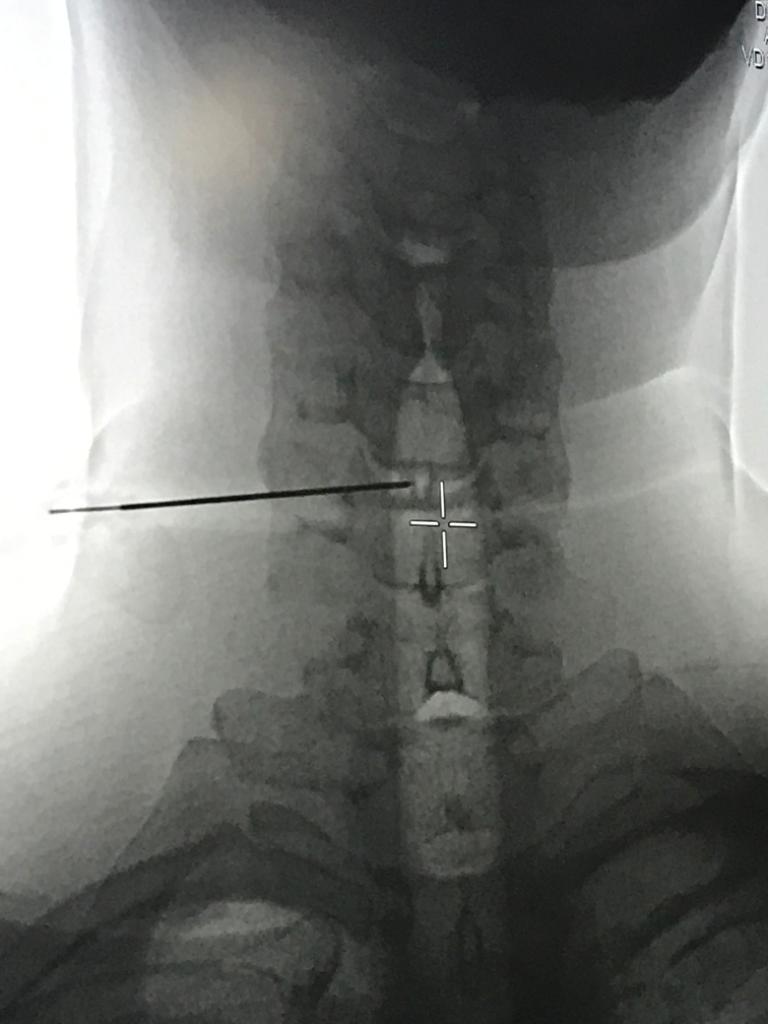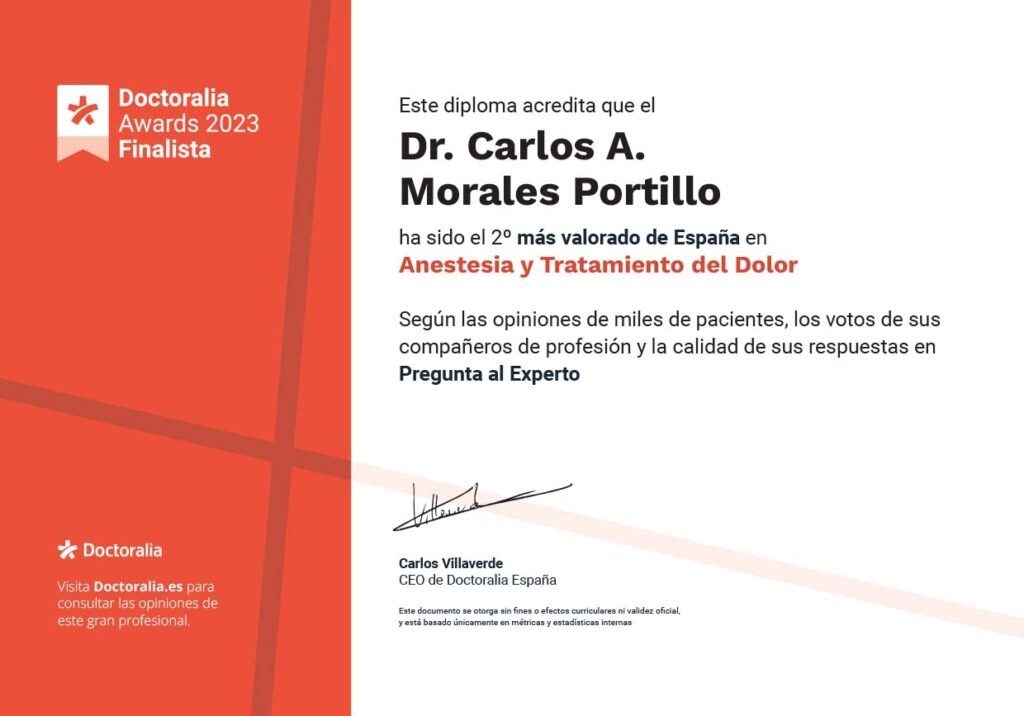Laser treatment for herniated disc without surgery
Disc herniation is one of the most disabling back problems that exist, but thanks to new techniques such as laser treatment, sufferers can forget about pain and avoid surgery.
If you want to opt for this treatment, which is less costly and risky than surgery but just as effective, you can request your treatment now.
What is a herniated disc and what symptoms does it produce?
One of the main back problems faced by many middle-aged people is the dreaded herniated disc. This injury is detrimental to the quality of life of those who suffer from it, because of how extremely painful it can be.
A herniated disc occurs when the discs of the spine become damaged and the contents of the nucleus pulposus begin to protrude from the annulus fibrosus. This can cause compression and inflammation on the nerves.
Disc herniation can cause intense pain in the extremity in the form of sciatica or lumbosciatica in cases of lumbar herniation or brachialgia or cervicobrachialgia in cases of cervical herniation.
Although in most cases the acute pain subsides in 2 to 3 months, 37-54% of patients continue to experience pain after one year and may become chronic. In the past, the only way to treat this problem was by surgery. However, spine surgery is not without risk.
The risks of herniated disc surgery in the spine
If you are considering surgery to remove your herniated disc, you should be aware of the risks involved. There is always a risk of complications with any surgery. Bleeding, infection and nerve damage are possible complications of surgery to remove a herniated disc. The risks of these complications increase if you have other health problems.
The success rate of this type of hernia removal surgery is also not 100%. It is estimated to be 70%. In some cases, the herniated disc may recur after surgery, requiring reoperation in 10% of cases. You may also experience pain and stiffness in the affected area for some time after surgery. That’s why many patients come to the Pain Unit to ask how to fix a herniated disc without surgery.
Measures and treatments for herniated disc without surgery
It is easy to detect a herniated disc in a patient with low back pain or sciatica thanks to magnetic resonance imaging. Once diagnosed, it is usual to start a conservative herniated disc treatment with oral anti-inflammatory drugs, accompanied by rehabilitation. However, treatment of herniated disc pain with medication and physical therapy can be a lengthy process.
Not all patients can or should take anti-inflammatory drugs for months at a time because of the risks involved. In addition, not all patients respond to mediation. In these patients it is worth considering what treatment options are available before surgery is considered.
Can a herniated disc be cured without laser surgery? How to avoid a herniated disc operation
This novel technique consists of applying a laser through a needle, directly inside the herniated discs. The first step is to locate the intervertebral disc to be treated by means of X-rays, CT or both. Once the needle is inserted, a special laser fiber is passed into the disc. The laser treatment is automated in several cycles, and produces a thermocoagulation of the nucleus of the hernia, thus dissolving and decompressing the adjacent nerves in a matter of minutes.
There are different laser technologies that allow this technique to be performed, but it is important that they meet a series of conditions. The most important thing to take into account is that the temperature remains stable, ideally not reaching 50º during the process to avoid any damage to the nerves or adjacent structures when acting.
This treatment is performed under local anesthesia and light sedation so that it is not painful. It is a 100% ambulatory process, and the medical discharge is done in less than an hour, and requires only 24 hours of relative rest.
The results are immediate, on the one hand, and due to a mechanical effect, a herniated disc can disappear and stop compressing the nerve. In addition, thanks to the photobiological effect of the laser, the inflammation around the nerve is reduced. This technique is compatible with the use of other intradiscal techniques such as ozone, and does not contraindicate the possibility of surgery if necessary.
What does percutaneous laser decompression of herniated discs consist of?
If you have experienced numbness, weakness or pain that radiates from the back to the legs, it is possible what treatments are available if you have a herniated disc. Among the options available to treat a herniated disc without surgery, this new laser technique that manages to act directly on the disc lesion, which can correct the cause of pain quickly and also very minimally invasive.
This innovative technique is developed thanks to the most advanced technology, and allows to obtain the best results in the treatment of herniated disc without surgery with a single session.
The application of this percutaneous laser technique will avoid the need to resort to surgery in many cases, since the success rate after its use in herniated discs, has a very encouraging success rate of between 60% and 80%. It is also more effective than infiltrations in case of disc herniation.
Types of lasers used in the treatment of herniated discs in the spine
When planning the treatment of a herniated disc in the spine, it is possible to find different types of lasers, with different characteristics, specifications and advantages.
On the one hand, there is the Logsa NEO Laser, which uses a pulsed light of Neodymium YAG (Nd:YAG) type, and has a wavelength of 1470 nm, being able to develop a power of up to 7W.
On the other hand, the Discolux Laser uses a pulsed light type Holmium YAG (Ho:YAG) with a wavelength of 2100 nm that reaches a power of 1.5W.
Both laser probes are very thin but the neodymium one is the thinner of the two, with the advantage that it is channelable by 22 G guide (vs. 20 G used by the Holmium laser).
What are the advantages of the Logsa Neodymium laser and the Discolux Holmium laser?
Depending on the type of hernia, the size, and the lumbar or cervical location, it is more advisable to resort to a different treatment with a particular type of laser.
Thus, for example, when suffering from a bulky herniated disc, it is more convenient to use a Logsa Neodymium laser, since less thermal dissipation is obtained at the same energy delivery. This allows a vaporization at 60º with a precision of 3mm, achieving a greater reduction of the hernia volume.
On the other hand, the Holmium laser offers other interesting advantages. The discolux laser is less aggressive, and its effect only penetrates about 0.32 mm (the Neodymium laser penetrates up to 0.58 mm).
This lower penetration rate makes the Holmium laser more suitable for treating cervical hernias, since it is less aggressive for the area to be treated.
The discolux laser, being less aggressive, may involve less recovery time, and the patient can return to his daily life without problems before.
Video about Discolux laser treatment for herniated discs
This video demonstrates the percutaneous laser herniated disc treatment technique. It is a minimally invasive procedure that can be used to treat pain and disability caused by a herniated disc. The laser is used to shrink the herniated disc and relieve pressure on the nerve root.
The benefits of laser treatment of herniated discs
This technique is considered by specialists as one of the best alternatives to treat herniated discs, whether lumbar, cervical or dorsal, due to its speed in taking effect, its low aggressiveness and its excellent long-term results, making it an option to consider in order to avoid undergoing surgery.
The objective of the treatment is to reduce the inflammation and the size of the injury, and in this way, the patient achieves a significant improvement in pain and mobility, and can quickly and satisfactorily return to normal activity, reducing the recovery time to a few days.
This treatment therefore helps to avoid surgery and its complications, and that the injury becomes a permanent ailment in the form of chronic pain, because the patient can return to normal activities of their routine gradually, which is very positive for the prognosis of the disc injury to break the vicious circle of pain-immobility.
An important advantage of the treatment is the precision of the intervention, since the laser channel is applied in the very core of the hernia with X-rays. This treatment evaporates the hernia material in a few minutes (in order to reduce the internal pressure).
Another advantage of this type of treatment is that it is a very comfortable procedure, which allows the patient to be discharged the same day and without the need for a postoperative period.
In addition, the versatility of laser treatment allows it to be used not only for the treatment of herniated lumbar discs, but also to correct cervical and dorsal discs.
Likewise, in this type of treatment, since it is performed through a cannula (a hollow needle through which the laser passes), there are no surgical wounds, thus avoiding the appearance of complications due to fibrosis in the back. The use of this technique does not hinder the performance of future surgery in the area if necessary in the future.
The disadvantages of herniated disc laser treatment
These techniques are, in most cases, a great option for the first six to eight weeks that pain is detected, however, laser disc herniation surgery is not for everyone.
Patients who are candidates for this treatment are those who have suffered a disc injury in the form of herniation, extrusion or bulky protrusion at the cervical, dorsal or lumbar level and have disabling pain in the form of sciatica due to compression of a nerve root (L4, L5 and S1 are the most frequent).
Before treatment, a detailed medical evaluation and a complementary imaging test (MRI) are needed to rule out warning signs that would suggest the need for surgery, although less than 5% of herniated discs currently require surgery, thanks to non-surgical alternatives.
We are not talking about a herniated disc operation with laser, this treatment is not a surgery and therefore has a low risk of complications in patients (less than 0.1%) and are usually reduced to mild transient pain. The most serious risk of this technique is infection (discitis), a risk that is greatly minimized by sterility and the use of antibiotics.
Contraindications for the use of this technique are scarce, although it is worth mentioning severe coagulation disorders or infection in the area. Iodinated contrast is used in this technique, and although its use is not essential, in case of allergy to this mediation it is important to notify it.
Download the laser herniated disc PDF infographic
Laser and ozone herniated disc treatment is a non-invasive procedure that offers fast and effective results. Learn more about laser herniated disc treatment and results Download the laser herniated disc treatment PDF infographic now. Click here to download the PDF infographic.
Opinions, reviews and comments on treatments at the Pain Unit in Malaga
 Unidad del Dolor Málaga - Hospital HM Santa Elena | Santias | Asisa| Adeslas | Mapfre | Caser | Cigna | Medifiatc | Cosalud
Unidad del Dolor Málaga - Hospital HM Santa Elena | Santias | Asisa| Adeslas | Mapfre | Caser | Cigna | Medifiatc | Cosalud
Calle Sardinero, Torremolinos
4,7 18 reviews
-
Rosa Lopez ★★★★★ Hace 2 meses
El Dr. Morales ya me hizo varios tratamientos de rizotomía en cervicales con ozono y desde que empecé, he mejorado mucho. Hoy he vuelto a acudir y quiero agradecer de nuevo al doctor especialmente, que mientras trabaja me va informando … More de lo que va haciendo, está a la escucha, es paciente y amable. Pero también quiero dar las gracias a todo el equipo que trabaja allí: enfermerxs, celadorxs, recepción . Son todos cercanos, amables, comprensibles, grandes profesionales. El hospital impoluto y moderno (lo único malo, el aparcamiento). Los tratamientos del Doctor Morales son los únicos que me ayudan a tener una vida más "normal" y con menos dolores, gracias Doctor! -
Vicente B ★★★★★ Hace un año
D. Carlos es el único doctor que me ha ayudado a mejorar de mi hernia discal. Con sus intervenciones en la Unidad del Dolor, tanto en Quiron como en Santa Elena. Hace un año no podía andar apenas. Ahora camino casi todos los días más de … More una hora. Tengo 64 años. Le estoy muy agradecido. -
felix angel Barderas ★★★★★ Hace un año
Recientemente me ha efectuado dos procedimientos para tratar mis problemas de columna, rizolisis bilateral y discolisis, estoy empezando a obtener el resultado de los mismos, muy satisfecho por la mejoría obtenida. Me transmite mucha confianza … More y su equipo humano y técnico son de primer nivel. -
Rocío Martínez ★★★★★ Hace un año
Sin duda alguna fué el único médico que supo escucharme y dar remedio a mis problemas,gracias a él puedo llevar una vida normal.....no hay palabras para agradecer a doctor Morales la calidad de vida que he ha hecho ganar!! -
F. Javier Torres ★★★★★ Hace un año
Gran profesional. Excelente formación y trato al paciente. Seguro y eficaz.
Atención rápida sin esperas.
Location of Specialist in the treatment of herniated discs in Malaga
Dr. Carlos Morales, pain specialist, consults at Hospital Santa Elena and Clínica Élite in Torremolinos, Malaga. Both centers have parking and good access from Avenida Manuel Fraga Iribarne, and are accessible by public transport thanks to the Los Alamos commuter train station and through the Los Alamos stop on the M-110 bus line.
Expert opinion on how to cure a herniated disc without surgery
Laser treatment is nowadays one of the best non-surgical options for the treatment of cervical, dorsal or lumbar disc herniations. This treatment is effective and very safe, being able to control the pain and reduce the volume of the hernia permanently, thus avoiding the complications that surgery can have.
Anesthesiologist specializing in pain management
Four masters in the area of pain management, including the title of Expert in pain 2019 by the University of Cadiz.
TopDoctors 2021 Certificate of Excellence for the opinions of his patients.






